Dementia Care: Comparing Facilities and Proposing Improvements
VerifiedAdded on 2021/04/17
|8
|1556
|70
Report
AI Summary
This report examines dementia care facilities, focusing on the Dementia Village in the Netherlands and a traditional nursing home. It analyzes the strengths and weaknesses of each, highlighting the Village's innovative design and the nursing home's clinical environment. The report proposes a model for an ideal dementia care facility, drawing inspiration from the Dementia Village while incorporating elements to enhance patient well-being and quality of life. The proposed facility emphasizes a village-like structure, multidisciplinary care teams, and a focus on reducing clinical aspects to create a more homelike environment. It also addresses potential safety hazards and promotes patient autonomy and engagement in various activities. The report stresses the importance of a non-clinical atmosphere and financial accessibility to improve the care of dementia patients.
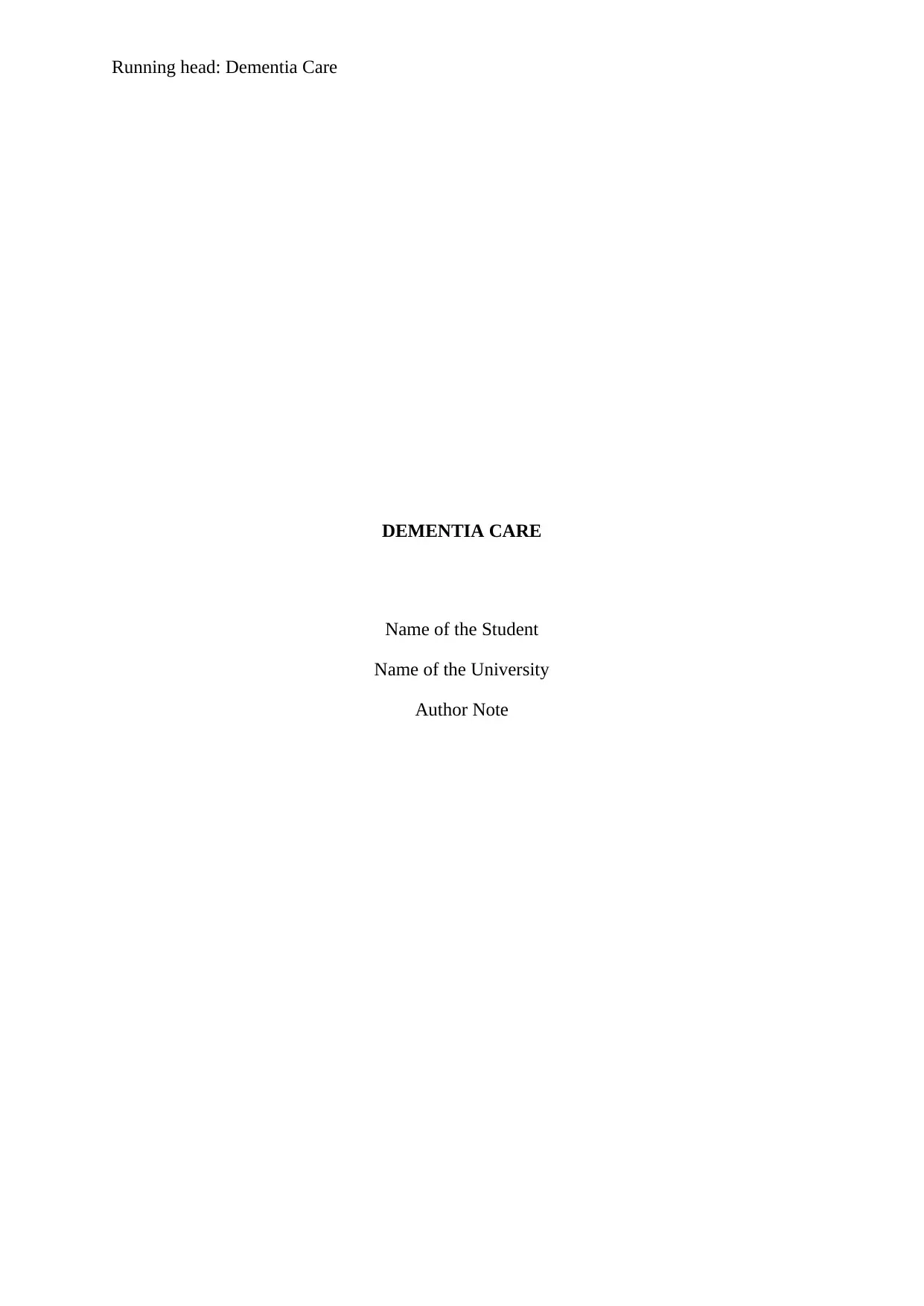
Running head: Dementia Care
DEMENTIA CARE
Name of the Student
Name of the University
Author Note
DEMENTIA CARE
Name of the Student
Name of the University
Author Note
Paraphrase This Document
Need a fresh take? Get an instant paraphrase of this document with our AI Paraphraser
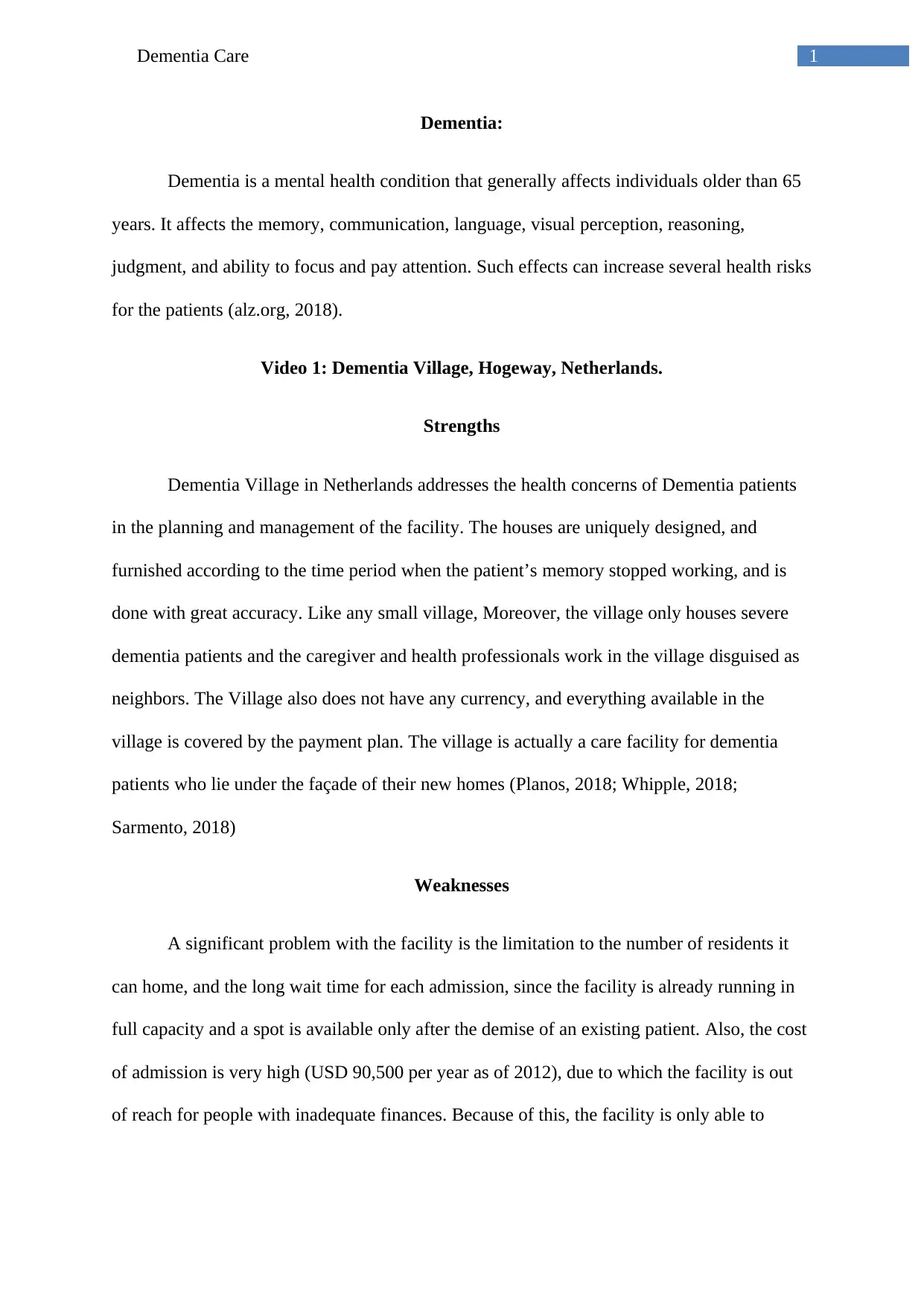
1Dementia Care
Dementia:
Dementia is a mental health condition that generally affects individuals older than 65
years. It affects the memory, communication, language, visual perception, reasoning,
judgment, and ability to focus and pay attention. Such effects can increase several health risks
for the patients (alz.org, 2018).
Video 1: Dementia Village, Hogeway, Netherlands.
Strengths
Dementia Village in Netherlands addresses the health concerns of Dementia patients
in the planning and management of the facility. The houses are uniquely designed, and
furnished according to the time period when the patient’s memory stopped working, and is
done with great accuracy. Like any small village, Moreover, the village only houses severe
dementia patients and the caregiver and health professionals work in the village disguised as
neighbors. The Village also does not have any currency, and everything available in the
village is covered by the payment plan. The village is actually a care facility for dementia
patients who lie under the façade of their new homes (Planos, 2018; Whipple, 2018;
Sarmento, 2018)
Weaknesses
A significant problem with the facility is the limitation to the number of residents it
can home, and the long wait time for each admission, since the facility is already running in
full capacity and a spot is available only after the demise of an existing patient. Also, the cost
of admission is very high (USD 90,500 per year as of 2012), due to which the facility is out
of reach for people with inadequate finances. Because of this, the facility is only able to
Dementia:
Dementia is a mental health condition that generally affects individuals older than 65
years. It affects the memory, communication, language, visual perception, reasoning,
judgment, and ability to focus and pay attention. Such effects can increase several health risks
for the patients (alz.org, 2018).
Video 1: Dementia Village, Hogeway, Netherlands.
Strengths
Dementia Village in Netherlands addresses the health concerns of Dementia patients
in the planning and management of the facility. The houses are uniquely designed, and
furnished according to the time period when the patient’s memory stopped working, and is
done with great accuracy. Like any small village, Moreover, the village only houses severe
dementia patients and the caregiver and health professionals work in the village disguised as
neighbors. The Village also does not have any currency, and everything available in the
village is covered by the payment plan. The village is actually a care facility for dementia
patients who lie under the façade of their new homes (Planos, 2018; Whipple, 2018;
Sarmento, 2018)
Weaknesses
A significant problem with the facility is the limitation to the number of residents it
can home, and the long wait time for each admission, since the facility is already running in
full capacity and a spot is available only after the demise of an existing patient. Also, the cost
of admission is very high (USD 90,500 per year as of 2012), due to which the facility is out
of reach for people with inadequate finances. Because of this, the facility is only able to
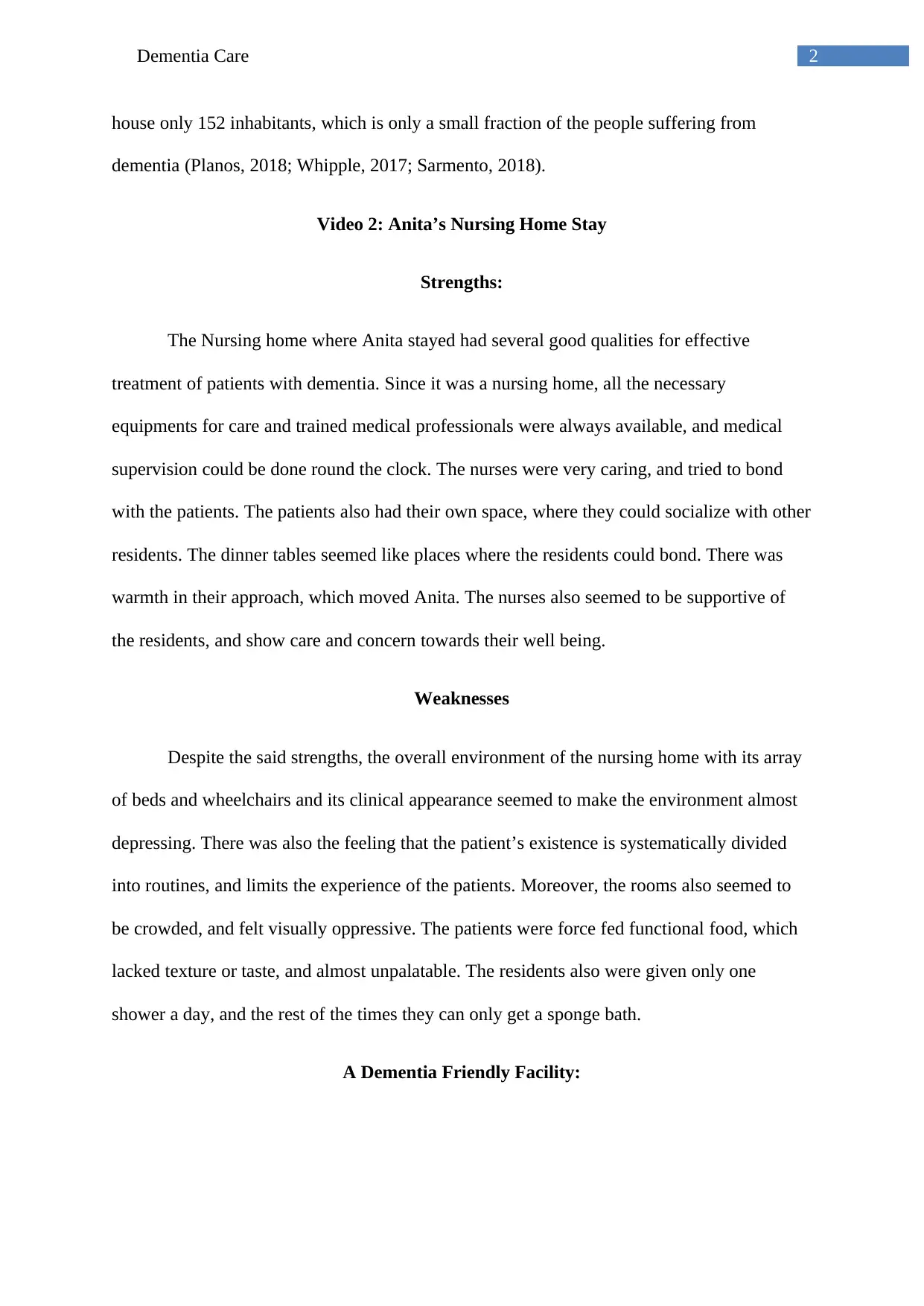
2Dementia Care
house only 152 inhabitants, which is only a small fraction of the people suffering from
dementia (Planos, 2018; Whipple, 2017; Sarmento, 2018).
Video 2: Anita’s Nursing Home Stay
Strengths:
The Nursing home where Anita stayed had several good qualities for effective
treatment of patients with dementia. Since it was a nursing home, all the necessary
equipments for care and trained medical professionals were always available, and medical
supervision could be done round the clock. The nurses were very caring, and tried to bond
with the patients. The patients also had their own space, where they could socialize with other
residents. The dinner tables seemed like places where the residents could bond. There was
warmth in their approach, which moved Anita. The nurses also seemed to be supportive of
the residents, and show care and concern towards their well being.
Weaknesses
Despite the said strengths, the overall environment of the nursing home with its array
of beds and wheelchairs and its clinical appearance seemed to make the environment almost
depressing. There was also the feeling that the patient’s existence is systematically divided
into routines, and limits the experience of the patients. Moreover, the rooms also seemed to
be crowded, and felt visually oppressive. The patients were force fed functional food, which
lacked texture or taste, and almost unpalatable. The residents also were given only one
shower a day, and the rest of the times they can only get a sponge bath.
A Dementia Friendly Facility:
house only 152 inhabitants, which is only a small fraction of the people suffering from
dementia (Planos, 2018; Whipple, 2017; Sarmento, 2018).
Video 2: Anita’s Nursing Home Stay
Strengths:
The Nursing home where Anita stayed had several good qualities for effective
treatment of patients with dementia. Since it was a nursing home, all the necessary
equipments for care and trained medical professionals were always available, and medical
supervision could be done round the clock. The nurses were very caring, and tried to bond
with the patients. The patients also had their own space, where they could socialize with other
residents. The dinner tables seemed like places where the residents could bond. There was
warmth in their approach, which moved Anita. The nurses also seemed to be supportive of
the residents, and show care and concern towards their well being.
Weaknesses
Despite the said strengths, the overall environment of the nursing home with its array
of beds and wheelchairs and its clinical appearance seemed to make the environment almost
depressing. There was also the feeling that the patient’s existence is systematically divided
into routines, and limits the experience of the patients. Moreover, the rooms also seemed to
be crowded, and felt visually oppressive. The patients were force fed functional food, which
lacked texture or taste, and almost unpalatable. The residents also were given only one
shower a day, and the rest of the times they can only get a sponge bath.
A Dementia Friendly Facility:
⊘ This is a preview!⊘
Do you want full access?
Subscribe today to unlock all pages.

Trusted by 1+ million students worldwide

3Dementia Care
My idea for a perfect facility for Dementia patients is largely based on the structure of
the Dementia Village of Holland, and incorporates few other aspects to ensure the overall
care of the patients. These aspects will be discussed next.
In order to support larger number of patients, the village/facility will aim to house
more than 500 residents, and also have provisions for further increase. The facility will be
designed like a village, and all healthcare professionals and caregivers will be living in the
village along with the residents. A multidisciplinary team of professionals will be involved in
the care, including general physicians, nurses, psychologists, pharmacologist, social support
workers, spiritual counselors and counselors for healthily living. The facility will not only
focus on the health needs of the patient, but also try to improve their quality of life and enable
them to lead a meaningful life (Bowling et al., 2015).
The patients will have access to community halls, theaters, playgrounds and gardens,
where they can be monitored non-intrusively. Since the dementia patients are often confused
about their surroundings, which increases their risks of accidents and falls, any risks that can
lead to accidents will be properly analyzed, and considered while planning the facility. For
example, elevator switches can have automated sensors instead of switches, and operators to
help the patients. It is also important for the residents to feel a sense of freedom, as they can
move about on their own, without have to answer anyone’s queries (Tranvåg, 2018).. The
nurses will also try to foster the patient’s ability for self care activities, and therefore help to
maintain the quality of living among them.
The facility can also help the patients be involved in various activities, like gardening,
music, exercise or games (Mendes et al., 2016; Tompkins et al., 2016; Gregersen et al., 2017;
Guzmán et al., 2017). For this professionals/trainers/social support workers can be engaged
with the residents helping them to partake in such activities. Helping to develop a community
My idea for a perfect facility for Dementia patients is largely based on the structure of
the Dementia Village of Holland, and incorporates few other aspects to ensure the overall
care of the patients. These aspects will be discussed next.
In order to support larger number of patients, the village/facility will aim to house
more than 500 residents, and also have provisions for further increase. The facility will be
designed like a village, and all healthcare professionals and caregivers will be living in the
village along with the residents. A multidisciplinary team of professionals will be involved in
the care, including general physicians, nurses, psychologists, pharmacologist, social support
workers, spiritual counselors and counselors for healthily living. The facility will not only
focus on the health needs of the patient, but also try to improve their quality of life and enable
them to lead a meaningful life (Bowling et al., 2015).
The patients will have access to community halls, theaters, playgrounds and gardens,
where they can be monitored non-intrusively. Since the dementia patients are often confused
about their surroundings, which increases their risks of accidents and falls, any risks that can
lead to accidents will be properly analyzed, and considered while planning the facility. For
example, elevator switches can have automated sensors instead of switches, and operators to
help the patients. It is also important for the residents to feel a sense of freedom, as they can
move about on their own, without have to answer anyone’s queries (Tranvåg, 2018).. The
nurses will also try to foster the patient’s ability for self care activities, and therefore help to
maintain the quality of living among them.
The facility can also help the patients be involved in various activities, like gardening,
music, exercise or games (Mendes et al., 2016; Tompkins et al., 2016; Gregersen et al., 2017;
Guzmán et al., 2017). For this professionals/trainers/social support workers can be engaged
with the residents helping them to partake in such activities. Helping to develop a community
Paraphrase This Document
Need a fresh take? Get an instant paraphrase of this document with our AI Paraphraser

4Dementia Care
within the facility will help to collaborate the actions of the care professionals, as well have
therapeutic effect on the mental health of the residents (Camic, 2017).
Most importantly, utmost care will be given to ensure the facility does not have a
clinical look and looks and feels like a home to the patients. It is important to keep into
consideration the despair and confusions faced by dementia patients and care being taken to
reduce or eliminate any adverse experience faced by the patients. To prevent confusion
among the patients, no currency will be used in the facility, and all the services will be
covered under the plan. The residents can go to any local store or recreational center, and will
be availed with goods or services without any payments.
within the facility will help to collaborate the actions of the care professionals, as well have
therapeutic effect on the mental health of the residents (Camic, 2017).
Most importantly, utmost care will be given to ensure the facility does not have a
clinical look and looks and feels like a home to the patients. It is important to keep into
consideration the despair and confusions faced by dementia patients and care being taken to
reduce or eliminate any adverse experience faced by the patients. To prevent confusion
among the patients, no currency will be used in the facility, and all the services will be
covered under the plan. The residents can go to any local store or recreational center, and will
be availed with goods or services without any payments.
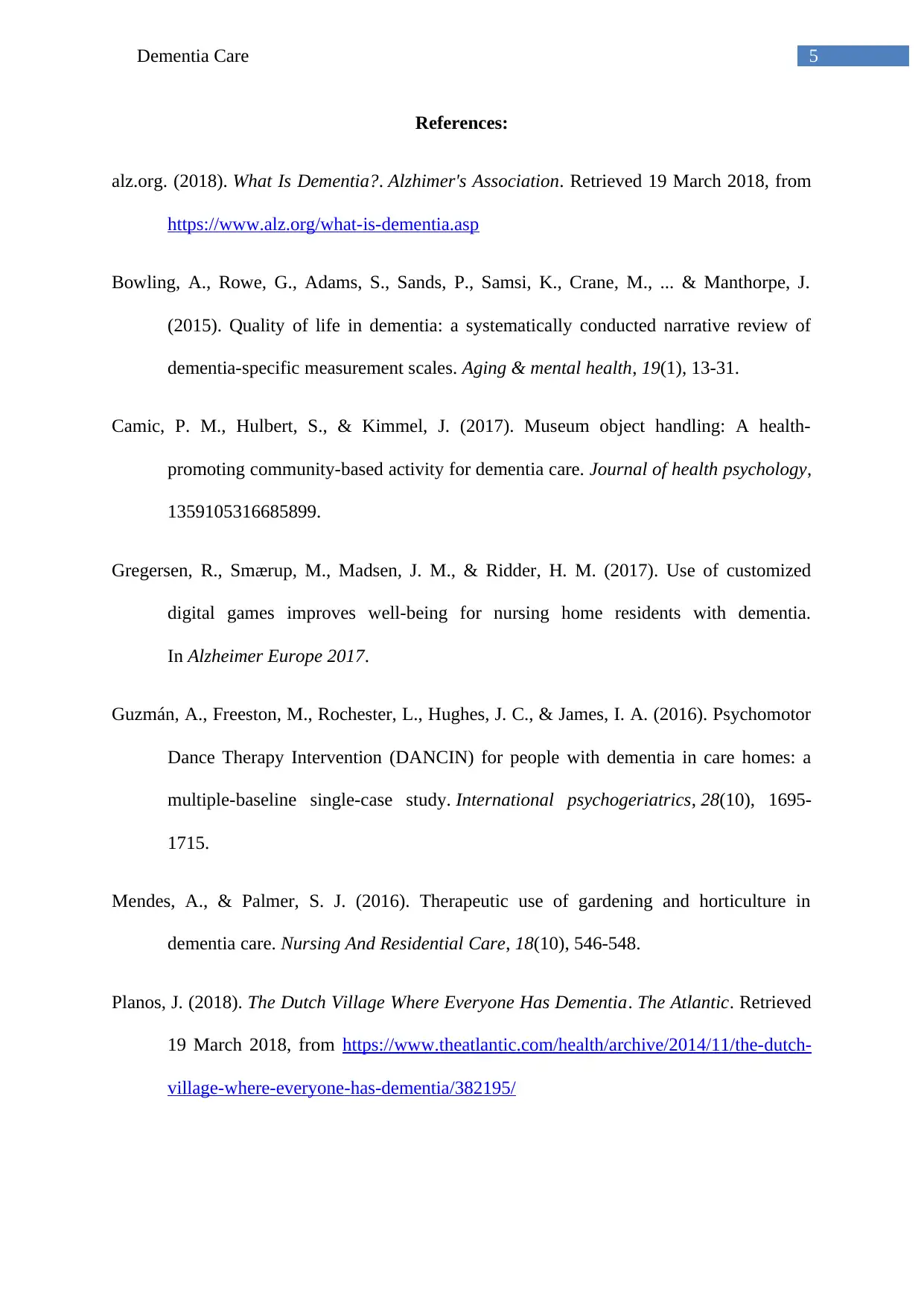
5Dementia Care
References:
alz.org. (2018). What Is Dementia?. Alzhimer's Association. Retrieved 19 March 2018, from
https://www.alz.org/what-is-dementia.asp
Bowling, A., Rowe, G., Adams, S., Sands, P., Samsi, K., Crane, M., ... & Manthorpe, J.
(2015). Quality of life in dementia: a systematically conducted narrative review of
dementia-specific measurement scales. Aging & mental health, 19(1), 13-31.
Camic, P. M., Hulbert, S., & Kimmel, J. (2017). Museum object handling: A health-
promoting community-based activity for dementia care. Journal of health psychology,
1359105316685899.
Gregersen, R., Smærup, M., Madsen, J. M., & Ridder, H. M. (2017). Use of customized
digital games improves well-being for nursing home residents with dementia.
In Alzheimer Europe 2017.
Guzmán, A., Freeston, M., Rochester, L., Hughes, J. C., & James, I. A. (2016). Psychomotor
Dance Therapy Intervention (DANCIN) for people with dementia in care homes: a
multiple-baseline single-case study. International psychogeriatrics, 28(10), 1695-
1715.
Mendes, A., & Palmer, S. J. (2016). Therapeutic use of gardening and horticulture in
dementia care. Nursing And Residential Care, 18(10), 546-548.
Planos, J. (2018). The Dutch Village Where Everyone Has Dementia. The Atlantic. Retrieved
19 March 2018, from https://www.theatlantic.com/health/archive/2014/11/the-dutch-
village-where-everyone-has-dementia/382195/
References:
alz.org. (2018). What Is Dementia?. Alzhimer's Association. Retrieved 19 March 2018, from
https://www.alz.org/what-is-dementia.asp
Bowling, A., Rowe, G., Adams, S., Sands, P., Samsi, K., Crane, M., ... & Manthorpe, J.
(2015). Quality of life in dementia: a systematically conducted narrative review of
dementia-specific measurement scales. Aging & mental health, 19(1), 13-31.
Camic, P. M., Hulbert, S., & Kimmel, J. (2017). Museum object handling: A health-
promoting community-based activity for dementia care. Journal of health psychology,
1359105316685899.
Gregersen, R., Smærup, M., Madsen, J. M., & Ridder, H. M. (2017). Use of customized
digital games improves well-being for nursing home residents with dementia.
In Alzheimer Europe 2017.
Guzmán, A., Freeston, M., Rochester, L., Hughes, J. C., & James, I. A. (2016). Psychomotor
Dance Therapy Intervention (DANCIN) for people with dementia in care homes: a
multiple-baseline single-case study. International psychogeriatrics, 28(10), 1695-
1715.
Mendes, A., & Palmer, S. J. (2016). Therapeutic use of gardening and horticulture in
dementia care. Nursing And Residential Care, 18(10), 546-548.
Planos, J. (2018). The Dutch Village Where Everyone Has Dementia. The Atlantic. Retrieved
19 March 2018, from https://www.theatlantic.com/health/archive/2014/11/the-dutch-
village-where-everyone-has-dementia/382195/
⊘ This is a preview!⊘
Do you want full access?
Subscribe today to unlock all pages.

Trusted by 1+ million students worldwide
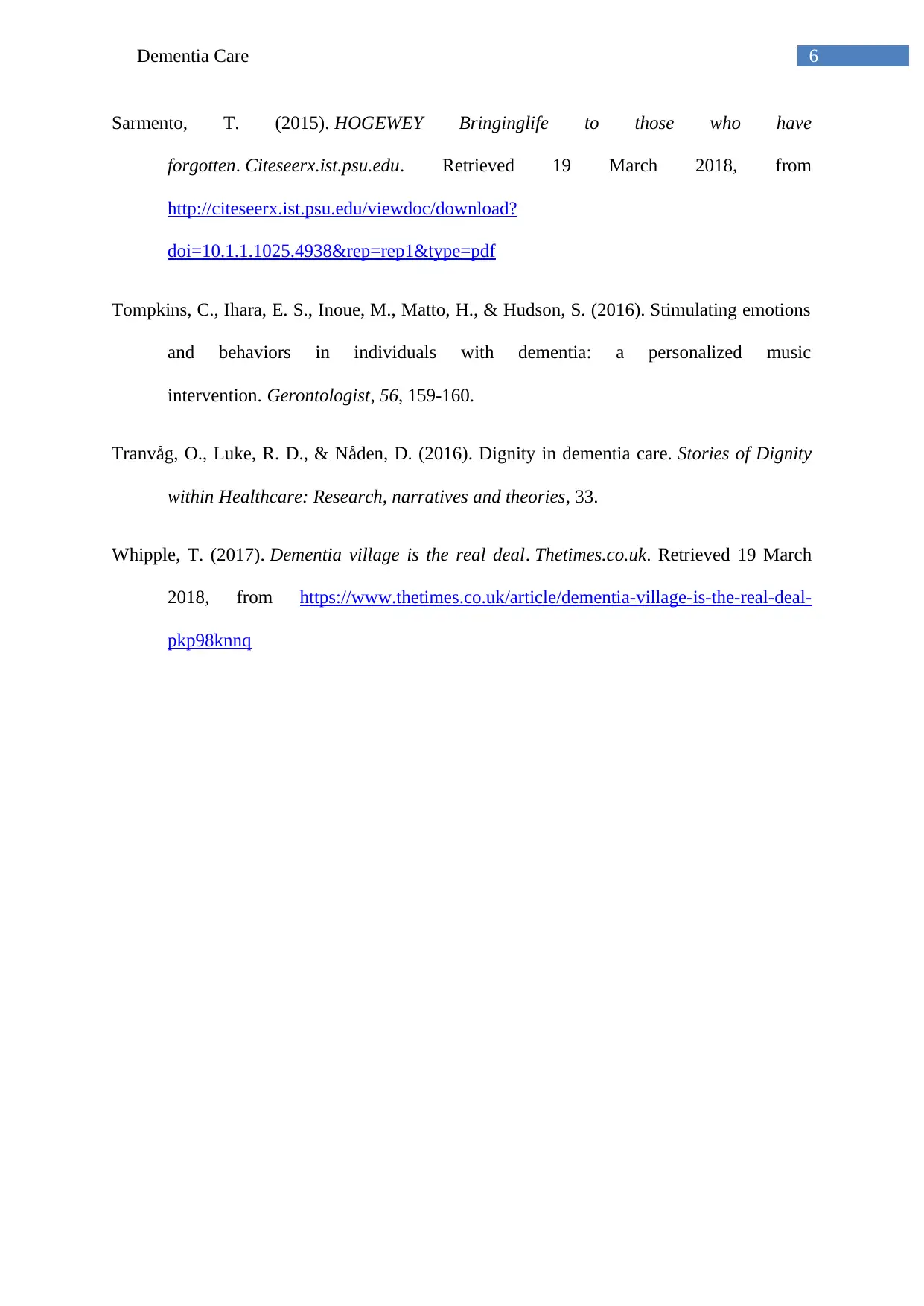
6Dementia Care
Sarmento, T. (2015). HOGEWEY Bringinglife to those who have
forgotten. Citeseerx.ist.psu.edu. Retrieved 19 March 2018, from
http://citeseerx.ist.psu.edu/viewdoc/download?
doi=10.1.1.1025.4938&rep=rep1&type=pdf
Tompkins, C., Ihara, E. S., Inoue, M., Matto, H., & Hudson, S. (2016). Stimulating emotions
and behaviors in individuals with dementia: a personalized music
intervention. Gerontologist, 56, 159-160.
Tranvåg, O., Luke, R. D., & Nåden, D. (2016). Dignity in dementia care. Stories of Dignity
within Healthcare: Research, narratives and theories, 33.
Whipple, T. (2017). Dementia village is the real deal. Thetimes.co.uk. Retrieved 19 March
2018, from https://www.thetimes.co.uk/article/dementia-village-is-the-real-deal-
pkp98knnq
Sarmento, T. (2015). HOGEWEY Bringinglife to those who have
forgotten. Citeseerx.ist.psu.edu. Retrieved 19 March 2018, from
http://citeseerx.ist.psu.edu/viewdoc/download?
doi=10.1.1.1025.4938&rep=rep1&type=pdf
Tompkins, C., Ihara, E. S., Inoue, M., Matto, H., & Hudson, S. (2016). Stimulating emotions
and behaviors in individuals with dementia: a personalized music
intervention. Gerontologist, 56, 159-160.
Tranvåg, O., Luke, R. D., & Nåden, D. (2016). Dignity in dementia care. Stories of Dignity
within Healthcare: Research, narratives and theories, 33.
Whipple, T. (2017). Dementia village is the real deal. Thetimes.co.uk. Retrieved 19 March
2018, from https://www.thetimes.co.uk/article/dementia-village-is-the-real-deal-
pkp98knnq
Paraphrase This Document
Need a fresh take? Get an instant paraphrase of this document with our AI Paraphraser

7Dementia Care
1 out of 8
Related Documents
Your All-in-One AI-Powered Toolkit for Academic Success.
+13062052269
info@desklib.com
Available 24*7 on WhatsApp / Email
![[object Object]](/_next/static/media/star-bottom.7253800d.svg)
Unlock your academic potential
Copyright © 2020–2025 A2Z Services. All Rights Reserved. Developed and managed by ZUCOL.





